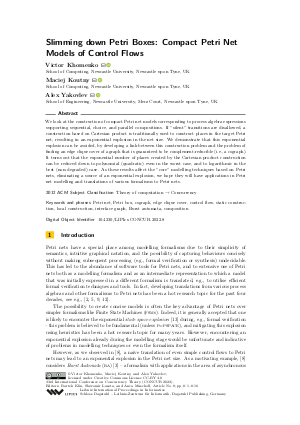Slimming down Petri Boxes: Compact Petri Net Models of Control Flows
Authors
Victor Khomenko  ,
Maciej Koutny
,
Maciej Koutny  ,
Alex Yakovlev
,
Alex Yakovlev 
-
Part of:
Volume:
33rd International Conference on Concurrency Theory (CONCUR 2022)
Part of: Series: Leibniz International Proceedings in Informatics (LIPIcs)
Part of: Conference: International Conference on Concurrency Theory (CONCUR) - License:
 Creative Commons Attribution 4.0 International license
Creative Commons Attribution 4.0 International license
- Publication Date: 2022-09-06
File

PDF
LIPIcs.CONCUR.2022.8.pdf
- Filesize: 0.84 MB
- 16 pages
Document Identifiers
Subject Classification
ACM Subject Classification
- Theory of computation → Concurrency
Keywords
- Petri net
- Petri box
- cograph
- edge clique cover
- control flow
- static construction
- local construction
- interface graph
- Burst automata
- composition
Metrics
- Access Statistics
-
Total Accesses (updated on a weekly basis)
0Document
0Metadata
Abstract
We look at the construction of compact Petri net models corresponding to process algebra expressions supporting sequential, choice, and parallel compositions. If "silent" transitions are disallowed, a construction based on Cartesian product is traditionally used to construct places in the target Petri net, resulting in an exponential explosion in the net size. We demonstrate that this exponential explosion can be avoided, by developing a link between this construction problem and the problem of finding an edge clique cover of a graph that is guaranteed to be complement-reducible (i.e., a cograph). It turns out that the exponential number of places created by the Cartesian product construction can be reduced down to polynomial (quadratic) even in the worst case, and to logarithmic in the best (non-degraded) case. As these results affect the "core" modelling techniques based on Petri nets, eliminating a source of an exponential explosion, we hope they will have applications in Petri net modelling and translations of various formalisms to Petri nets.
Cite As Get BibTex
Victor Khomenko, Maciej Koutny, and Alex Yakovlev. Slimming down Petri Boxes: Compact Petri Net Models of Control Flows. In 33rd International Conference on Concurrency Theory (CONCUR 2022). Leibniz International Proceedings in Informatics (LIPIcs), Volume 243, pp. 8:1-8:16, Schloss Dagstuhl – Leibniz-Zentrum für Informatik (2022)
https://doi.org/10.4230/LIPIcs.CONCUR.2022.8
BibTex
@InProceedings{khomenko_et_al:LIPIcs.CONCUR.2022.8,
author = {Khomenko, Victor and Koutny, Maciej and Yakovlev, Alex},
title = {{Slimming down Petri Boxes: Compact Petri Net Models of Control Flows}},
booktitle = {33rd International Conference on Concurrency Theory (CONCUR 2022)},
pages = {8:1--8:16},
series = {Leibniz International Proceedings in Informatics (LIPIcs)},
ISBN = {978-3-95977-246-4},
ISSN = {1868-8969},
year = {2022},
volume = {243},
editor = {Klin, Bartek and Lasota, S{\l}awomir and Muscholl, Anca},
publisher = {Schloss Dagstuhl -- Leibniz-Zentrum f{\"u}r Informatik},
address = {Dagstuhl, Germany},
URL = {https://drops.dagstuhl.de/entities/document/10.4230/LIPIcs.CONCUR.2022.8},
URN = {urn:nbn:de:0030-drops-170710},
doi = {10.4230/LIPIcs.CONCUR.2022.8},
annote = {Keywords: Petri net, Petri box, cograph, edge clique cover, control flow, static construction, local construction, interface graph, Burst automata, composition}
}
Author Details
References
- Eike Best, Raymond R. Devillers, and Jon G. Hall. The box calculus: a new causal algebra with multi-label communication. In Grzegorz Rozenberg, editor, Advances in Petri Nets 1992, The DEMON Project, volume 609 of Lecture Notes in Computer Science, pages 21-69. Springer, 1992. URL: https://doi.org/10.1007/3-540-55610-9_167.
-
Eike Best, Raymond R. Devillers, and Maciej Koutny. Petri net algebra. Monographs in Theoretical Computer Science. An EATCS Series. Springer, 2001.

-
A. Chan, Danil Sokolov, Victor Khomenko, David Lloyd, and Alex Yakovlev. Burst automaton: Framework for speed-independent synthesis using burst-mode specifications. submitted, 2021.

-
Jordi Cortadella, Michael Kishinevsky, Alex Kondratyev, Luciano Lavagno, and Alex Yakovlev. Logic Synthesis for Asynchronous Controllers and Interfaces. Springer, 2002.

-
Ursula Goltz and Alan Mycroft. On the relationship of CCS and Petri nets. In Jan Paredaens, editor, Automata, Languages and Programming, 11th Colloquium, Antwerp, Belgium, July 16-20, 1984, Proceedings, volume 172 of Lecture Notes in Computer Science, pages 196-208. Springer, 1984.

-
Jens Gramm, Jiong Guo, Falk Hüffner, and Rolf Niedermeier. Data reduction and exact algorithms for clique cover. ACM J. Experimental Algorithmics, 13, 2009.

-
C.A.R. Hoare. Communicating Sequential Processes. Prentice-Hall, 1985.

-
Victor Khomenko, Maciej Koutny, and Alex Yakovlev. Avoiding exponential explosion in Petri net models of control flows. In Proc. Petri Nets'22, Lecture Notes in Computer Science. Springer, 2022. accepted paper.

-
Victor Khomenko, Roland Meyer, and Reiner Hüchting. A polynomial translation of pi-calculus FCPs to safe Petri nets. Log. Methods Comput. Sci., 9(3), 2013.

-
H. Lerchs. On cliques and kernels. Tech. Report, Dept. of Comp. Sci., Univ. of Toronto, 1971.

-
Robin Milner. A Calculus of Communicating Systems. Springer, 1980.

-
Ernst-Rüdiger Olderog. Operational Petri net semantics for CCSP. In Grzegorz Rozenberg, editor, Advances in Petri Nets 1987, covers the 7th European Workshop on Applications and Theory of Petri Nets, Oxford, UK, June 1986, volume 266 of Lecture Notes in Computer Science, pages 196-223. Springer, 1986.

-
Antti Valmari. The state explosion problem. In Wolfgang Reisig and Grzegorz Rozenberg, editors, Lectures on Petri Nets I: Basic Models, Advances in Petri Nets, the volumes are based on the Advanced Course on Petri Nets, held in Dagstuhl, September 1996, volume 1491 of Lecture Notes in Computer Science, pages 429-528. Springer, 1996.

- Rob J. van Glabbeek and Ursula Goltz. Refinement of actions in causality based models. In J. W. de Bakker, Willem P. de Roever, and Grzegorz Rozenberg, editors, Stepwise Refinement of Distributed Systems, Models, Formalisms, Correctness, REX Workshop, Mook, The Netherlands, May 29 - June 2, 1989, Proceedings, volume 430 of Lecture Notes in Computer Science, pages 267-300. Springer, 1989. URL: https://doi.org/10.1007/3-540-52559-9_68.
